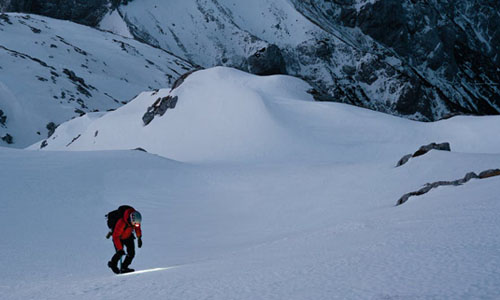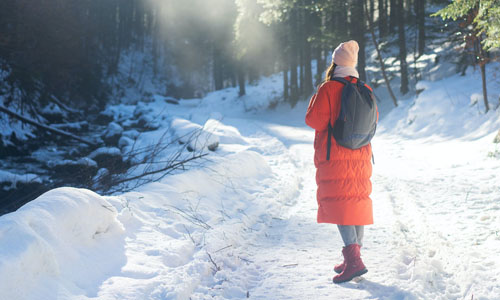Lessons to Learn from Snowy Winter Hike
Author

Chris shares his passion for cycling, hiking, skiing, and climbing from Buxton, in the Peak District. As a blogger for Outdoor Look, Chris shares outdoor tips and indoor tricks to help you get the most out of your time spent outside. When he's not out adventuring he's making videos or trying to keep up with his 4-year-old son.
Losing motivation is easy when the days get shorter and the weather gets colder. Heading outdoors during the cold winter months is not as easy as summer is way less ruthless than the winter. In winter, you cannot just tuck in the shoes and follow where the trail takes you. It requires a lot more in winter to hit the trail and a slight change in the mindset and the right kind of information can take you a long way where you can enjoy being outdoors with winter activity.
Staying active has loads of benefits and when you are hitting the road during the darker months, it will not just help you stay active, but improve mental health and boost your mood. So without much ado, let’s get started with the complete snow guide so that you enjoy and stay comfortable staying outdoors in winter.

General Tips to Remember
When you are hiking to the mountains in winter, you require more planning than usual as there are lots of safety precautions involved to face the harsh climatic elements.
- Remember that daylight hours are shorter during the winters so start your journey as early as possible so that you can cover the majority of the hike when there is still light. Avoid being out in the dark and have a plan prepared for such situations.
- The weather might seem calm and quiet at the ground level. But as you start to ascend the slope, it might change drastically. What will seem obvious at the foot of the hills might not be the same at the top. The movement of air and wind tends to get colder and harsher at higher altitudes.
- Cold temperatures make the technological devices malfunction and you should be ready for that. Be prepared with extra pair of batteries and backup of sorts. Also, try to keep the devices warm so that they do not leave you hung in mid-journey. Do not rely on your phone when you are on the trail.
- Going uphill or hiking during winters tend to burn more calories. So, stay well-nourished on the track as it will keep you warm too.
- Dehydration often leads to hypothermia. If you feel thirsty, then you are already dehydrated. Keep in mind to keep drinking water at regular intervals to avoid the situation of hypothermia.
Winter Hiking Clothing
The key to comfortable winter hiking is staying warm and dry. If you are sweating then you have worn the wrong kind of clothes. In the end, you will be all wet and cold. Dress up in three layers and avoid cotton at all costs. A thin and warm base layer, followed by a mid-layer and a waterproof outer layer is all you need. For winter hiking bottoms, consider wearing a base layer and a waterproof layer on top of it. Also, if you are comfortable, you can wear ski pants as well.

Winter Hiking Accessories
Pack a few extra pairs of gloves when you are hiking uphill and there is nothing more comfortable than warm hands. Make sure the gloves are lightweight and waterproof as they will be more appropriate when you are ascending the snowy uphill. Apart from the gloves, pay attention to hats and snow boots that are particularly made to hike uphill in the snowy mountains.
A Feeling of Fulfilment
No matter the wind and the cold outdoors lifting your spirit, staying well prepared with the information will help you fight the challenges, and come back home with some worthwhile experience.
Author

Chris shares his passion for cycling, hiking, skiing, and climbing from Buxton, in the Peak District. As a blogger for Outdoor Look, Chris shares outdoor tips and indoor tricks to help you get the most out of your time spent outside. When he's not out adventuring he's making videos or trying to keep up with his 4-year-old son.
- Speed Up Your Post-Hike Recovery with These 6 Essential Tips
- Cycling through Tranquil Roads and Coastal Views on the Isle of Wight
- The Essential Guide to Hiking Safety: 5 Tips Every Hiker Should Know
- Run Smart, Run Strong: Your Guide to Injury-Free Running
- Embrace Biking: Essential Tips for Beginners
Categories
- Sport (28)
- Product Reviews (3)
- Team Outdoor Look (7)
- Mike Wild (2)
- Mike Payton (2)
- Suse Hammond-Pears (3)
- Snowboarding (12)
- Latest Offers (105)
- Shop Talk (1)
- Competitions (7)
- Walking (413)
- Lifestyle Fashion (8)
- Travel (86)
- Kit Guides (176)
- Workwear Clothing (6)
- Safety Workwear (4)
- Health/Fitness (289)
- Skiing (91)
- Great Outdoors (1316)
- Cycling (92)
- January 2025
- December 2024
- November 2024
- October 2024
- September 2024
- August 2024
- July 2024
- June 2024
- May 2024
- April 2024
- March 2024
- February 2024
- January 2024
- December 2023
- November 2023
- October 2023
- September 2023
- August 2023
- July 2023
- June 2023
- May 2023
- April 2023
- March 2023
- February 2023
- January 2023
- December 2022
- November 2022
- October 2022
- September 2022
- August 2022
- July 2022
- June 2022
- May 2022
- April 2022
- March 2022
- February 2022
- January 2022
- December 2021
- November 2021
- October 2021
- September 2021
- August 2021
- July 2021
- June 2021
- May 2021
- April 2021
- March 2021
- February 2021
- January 2021
- December 2020
- November 2020
- October 2020
- September 2020
- August 2020
- July 2020
- June 2020
- May 2020
- April 2020
- March 2020
- February 2020
- January 2020
- December 2019
- November 2019
- October 2019
- September 2019
- August 2019
- July 2019
- June 2019
- May 2019
- April 2019
- March 2019
- February 2019
- January 2019
- December 2018
- November 2018
- October 2018
- September 2018
- August 2018
- July 2018
- June 2018
- May 2018
- April 2018
- March 2018
- February 2018
- January 2018
- December 2017
- November 2017
- October 2017
- September 2017
- August 2017
- July 2017
- June 2017
- May 2017
- April 2017
- March 2017
- February 2017
- January 2017
- December 2016
- November 2016
- October 2016
- September 2016
- August 2016
- July 2016
- June 2016
- May 2016
- April 2016
- March 2016
- February 2016
- January 2016
- December 2015
- November 2015
- October 2015
- September 2015
- August 2015
- July 2015
- June 2015
- May 2015
- April 2015
- March 2015
- February 2015
- January 2015
- December 2014
- November 2014
- October 2014
- September 2014
- August 2014
- July 2014
- June 2014
- May 2014
- April 2014
- March 2014
- February 2014
- January 2014
- December 2013
- November 2013
- October 2013
- September 2013
- August 2013
- July 2013
- June 2013
- May 2013
- April 2013
- March 2013
- February 2013
- January 2013
- December 2012
- November 2012
- October 2012
- September 2012
- August 2012
- July 2012
- June 2012
- May 2012
- April 2012
- March 2012
- February 2012
- January 2012
- December 2011
- November 2011
- October 2011
- September 2011
- August 2011
- May 2010
- April 2010
- March 2010
- February 2010
- January 2010
- November 2009
- October 2009
- September 2009
Submit a Comment